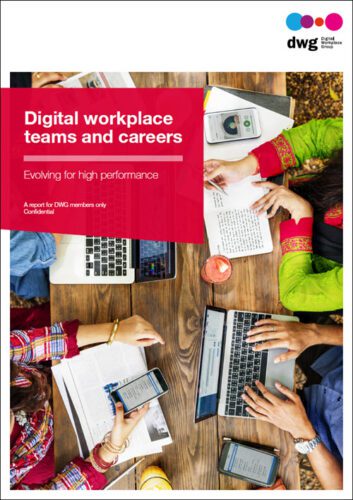Approaches to reducing the digital workplace carbon footprint
The digital workplace is well understood as a means of helping organizations reduce their overall carbon footprint and environmental impact. Remote work and virtual meetings can help limit business travel, paperless operations reduce paper and ink waste, energy efficiency through smart technologies – to mention a few of its positive impacts. But environmentally conscious organizations are also looking at the environmental impact of the digital workplace itself – for example from digital clutter or device disposal – and finding ways to reduce this.
In part one, digital workplace expert Annette Corbett explored psychological factors that can influence digital sustainability at work. In part two, she focuses on reducing the carbon footprint of the digital workplace itself. As well as sharing highlights from DWG survey data on practices that impact the carbon footprint of the digital workplace, she highlights approaches to help reduce this impact relating to managing both the digital workplace estate and the information it purveys.
Cleaning up the digital workplace: survey data
In 2023, DWG asked a sample of c.800 US and UK employees about some of their digital communication and information habits at work, as part of our research into the ‘green’ digital workplace.
The findings were:
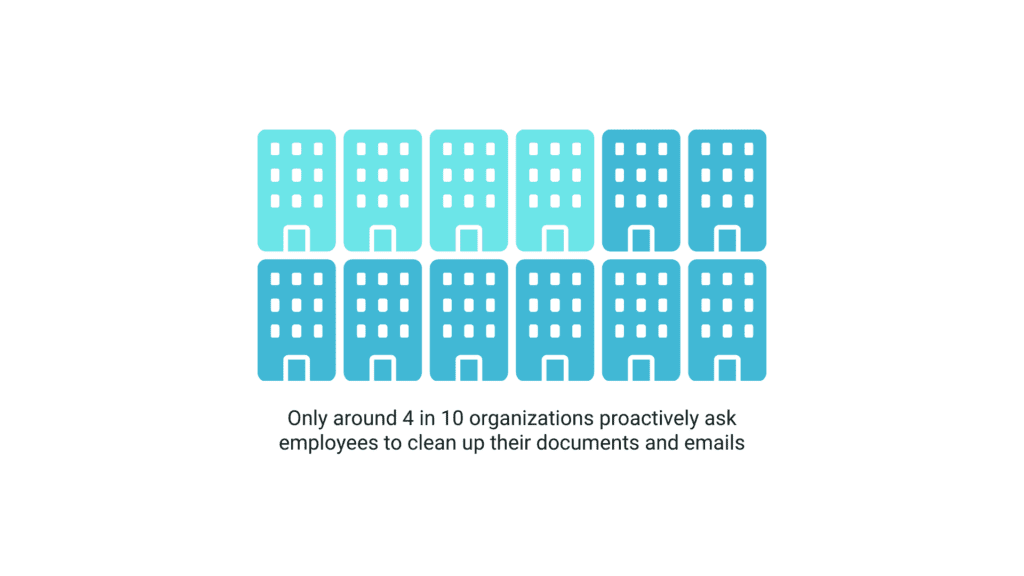
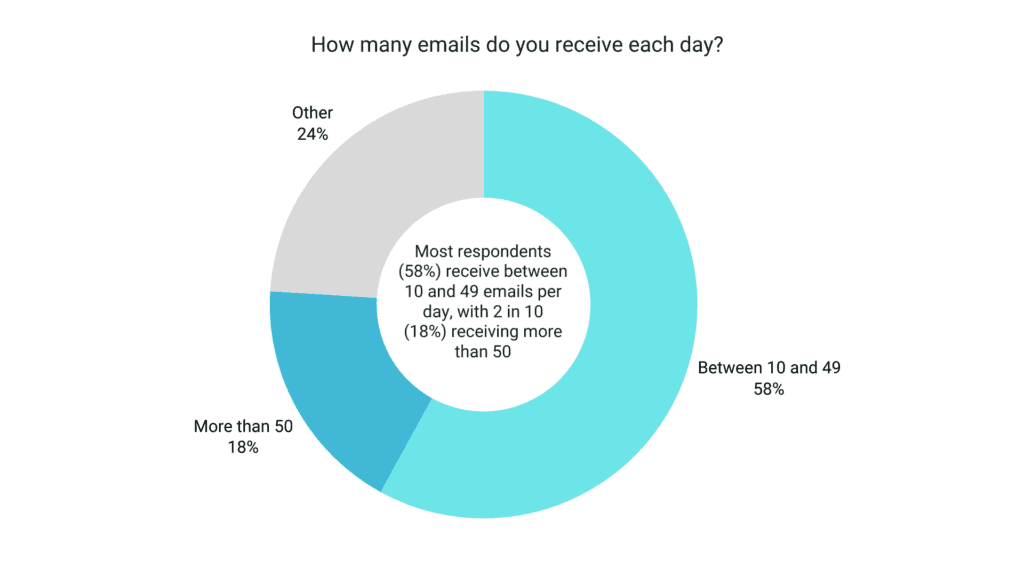
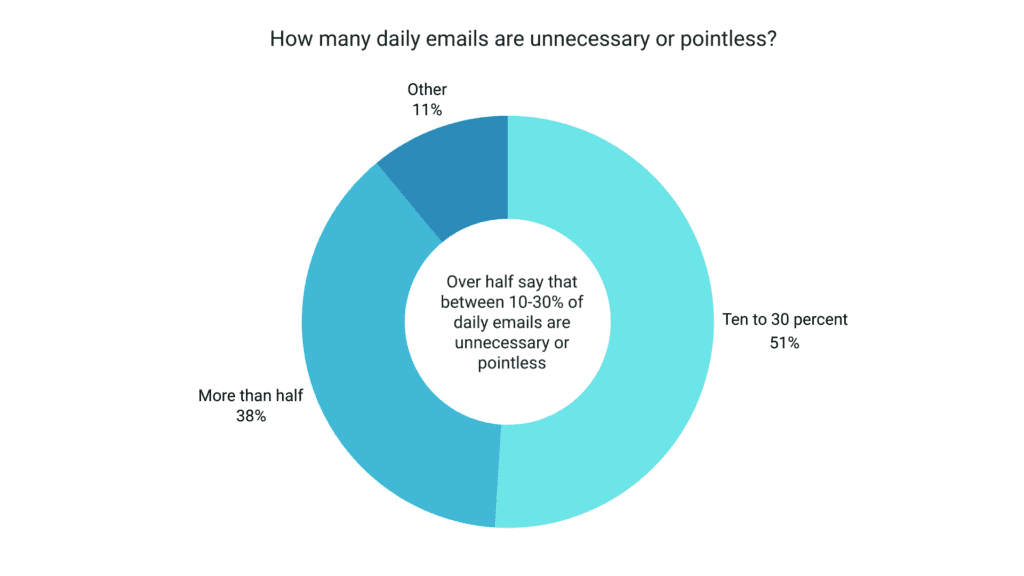
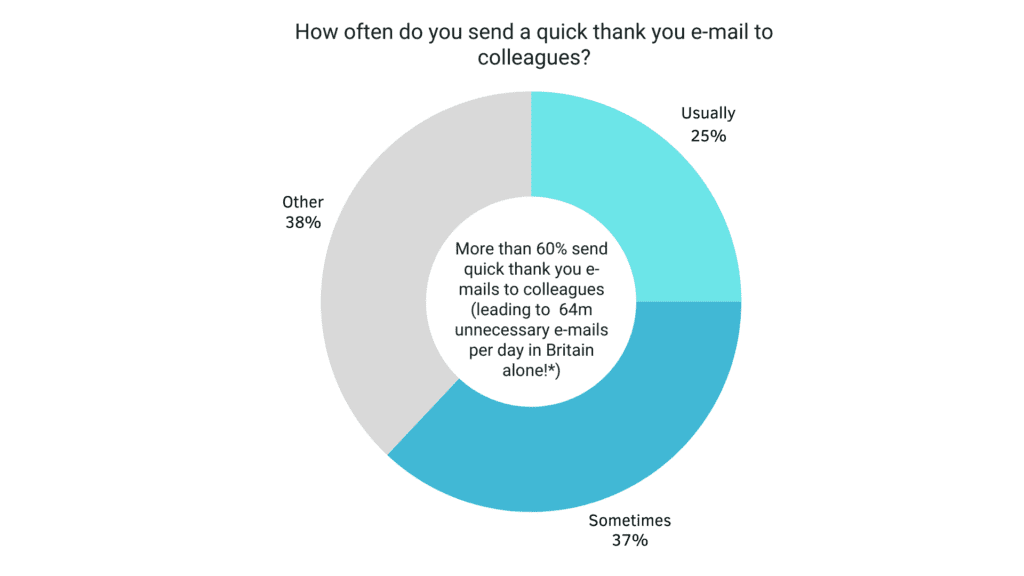
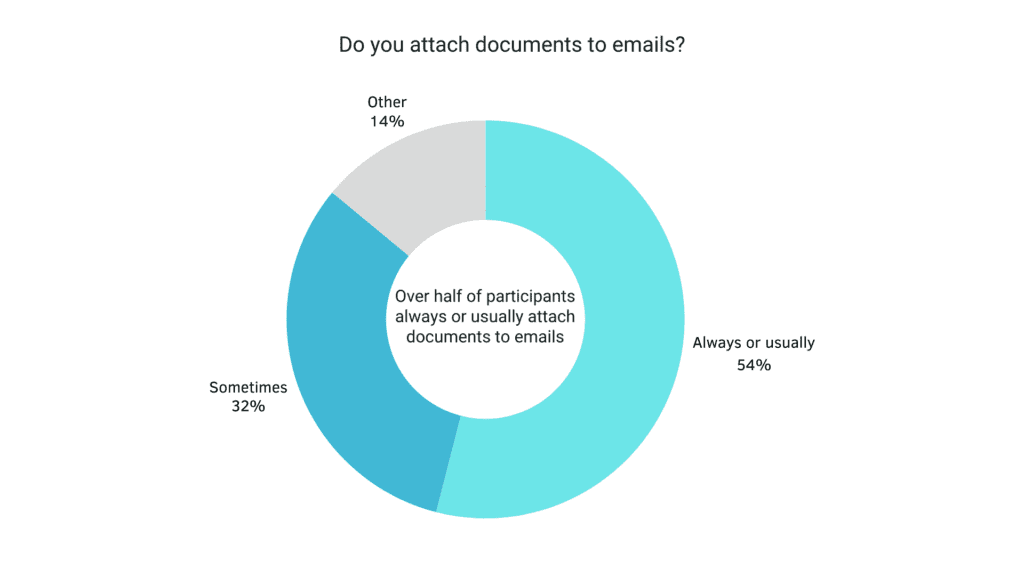
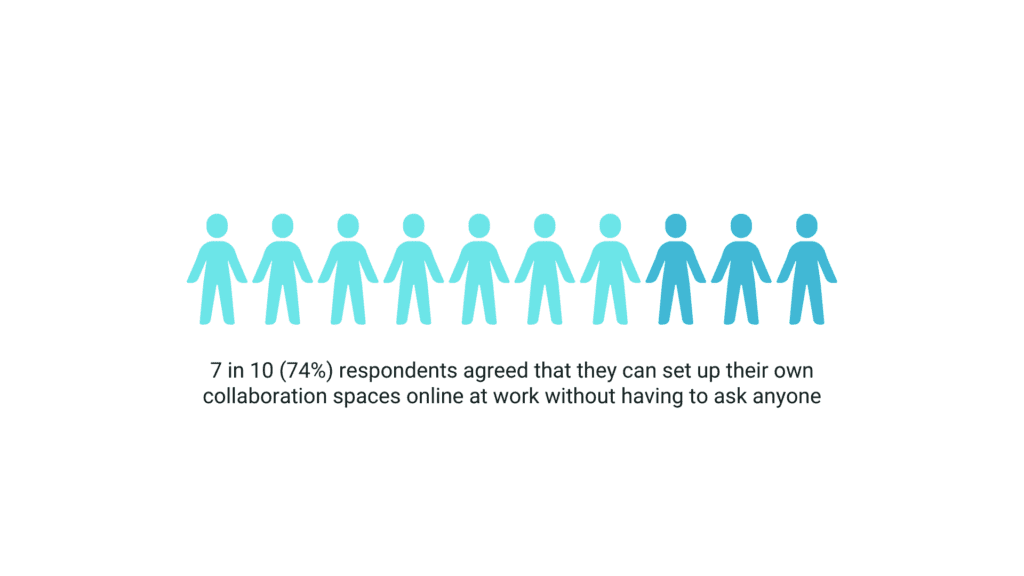
These findings suggest an array of embedded digital practices that may lead to a proliferation of digital clutter – including e-mails, documents, collaboration spaces – and a lack of organizational impetus to deal with it. Additional comments from respondents pointed to greater awareness of the need to go ‘paperless’ at work, while impacts from digital had not been considered and there was a lack of communication or awareness building in relation to digital clutter and impetus to reduce it. While specific research on the impact of digital workplace clutter is currently lacking, researchers have estimated that storing around 100 pictures in the cloud, along with some short videos, is equivalent to driving a car c. 17 kilometres in terms of energy consumption and carbon dioxide emissions, while each e-mail sent generates 4 grams of CO22.
On a positive note, there may be more impetus at an individual level: the majority of respondents (76%) said that they consciously try to reduce digital clutter at work (although this may reflect a degree of social desirability bias). Those concerned about the environmental impact of the digital workplace were more likely to make efforts in this respect.
Approaches to reducing the digital workplace carbon footprint
For digital workplace teams wanting to elevate the organization’s digital sustainability efforts there are a number of ways that their work can contribute in meaningful ways.
Streamline content with content strategy and design techniques
A proliferation of poor quality, media bloated content is bad for end-users trying to find information to power their tasks and can also add to an organization’s digital clutter.
It’s unlikely your current content strategy will speak to digital sustainability practices as sources of guidance and verifiable metrics remain nascent, but considering tools, content types, templates and lifecycle management as part of your content strategy will provide a solid foundation to meet future content sustainability targets.
Adopting minimalist and responsive design principles can both enhance the user experience while reducing energy consumption and a content strategy can steer editors to template types best suited for content. Website sustainability is comparably progressive and there is much we can learn from these practices, such as clear and efficient copywriting, content optimization, and writing clean code.3 Perhaps at its most basic, the content strategy must ask the question of time immemorial. Do we need this piece of content to be a site or a page? Can we boil it down to a simple message on social channels?
In his book, Designing for Sustainability, Tim Frick laments “our love affair with video, multi-image carousels, high-res images and other frontend bells and whistles which have caused an epidemic of slow, overloaded pages.”4 Superfluous words, gratuitous imagery and videos increase the digital weight of a page, creating “content bloat”. Not only does this make the task of finding relevant information a time-consuming challenge for users, but the energy used to serve up this smorgasbord of content is carbon calorific.
But it can be difficult to challenge the status quo when a canvas that is clean and streamlined could be sprinkled (or deluged) with aesthetics. This is where the practice of content design can become your ‘true north’. Content design is about providing clear, unambiguous signposting; information that is relevant (and stripped of excess) and the use of graphics or videos only where they provide context that’s essential.
Selective use of videos, graphics and images also reduce the size of your storage repository. This approach has the dual benefit of prioritizing the user experience as well as being a better choice for the environment.
Measure and manage the carbon footprint of digital workplace devices and applications
Sustainability adviser, Sarah Walkley PhD shares her experience of mobile phone supply chain in organizations, and how one prominent network provider provided upgrades irrespective of the demand for additional phones; rather like consumerism for consumerism’s sake5. This results in a perfectly serviceable mobile phone being superseded by its more progressive sibling, because the contract agreement doesn’t consider demand as part of its supply process.
Implementing a responsible IT purchasing policy is essential to ensure that equipment is renewed when needed rather than systematically. Adding environmental criteria to the tender process for purchasing equipment supports a more sustainable digital device plan. Persona creation is also important to help identify the typical technical requirements of an employee. Not everyone will need a ‘starter kit’ of keyboard, mouse, headphones and (cumbersome) laptop bag but often these are provided as part of onboarding, without any requirement gathering process.
In setting out ‘golden rules’ for a more sustainable digital workplace, Wavestone recommends: measuring the carbon footprint of IT equipment; repair and reuse of equipment; as well as a policy to donate to charity any equipment that is no longer fit for employee use. This latter ‘rule’ can mean that digital workplace devices can live out a valuable ‘second life’.
Sarah Walkley shares the example of a training organization, MER-IT, which uses donated technology to run traineeships and work experience placements, free community computer repair workshops and hardware courses for children. These initiatives have the collective effect of mitigating digital e-waste, ensuring a connected society respectful of its resources and community-based training opportunities.
When it comes to applications, environmentally focused IT service provider, Greenspector has examined the carbon impacts of popular workplace collaboration tools. They found, for instance, that one hour of streaming or videoconferencing can emit between 150 and 1,000 grams of carbon dioxide, depending on the service6, while a minute of writing and sending a text message consumes 3.33 mAh, which is 2 times less consumption than a minute of audio call7. Their analysis goes on to look at comparative impacts of different collaboration tools. This kind of analysis can help to inform the choice of applications for the organization but also provide evidence to digital workplace teams to help lobby vendors about improving their environmental performance.
Further downstream, streamlining the notifications and e-mails that can proliferate from digital workplace applications and services can also have a positive impact – for digital sustainability and for the precious resource of attention among employees! Features on intranets such as action inboxes are helping to collate such notifications and flag them prominently for user action, rather than sending out yet more emails.
Content and collaboration governance
When collaboration tools work, they work brilliantly, but they are not a catch-all for every situation, which teams can discover soon after their release into the wild. The result can be a graveyard of discarded Teams (or similar) spaces, collaboration hubs and intranet sites, many of which have no official ‘owner’ and fall through the cracks of governance by virtue of their obscurity.
A staggering 7 in 10 (68%) of DWG survey respondents agreed or strongly agreed that they can set up their own collaboration spaces online at work without having to go through any process to request them.
Collectively, these can turn into unwanted or discarded collaboration spaces, significantly contributing to the carbon footprint of our digital workplaces. Putting in place robust governance is essential to help end-users setting up such environments to think through their needs and the best digital solution to fulfill them. Such processes need not be arduous, for example using online forms to request spaces and fast approval processes for straightforward requests.
Along with processes to review and clean up the collaboration estate on a regular basis, streamlining provisioning in this way can make a positive contribution to reducing the carbon footprint of the digital workplace. It can also foster a better experience for users, especially where ‘What tool when’ tools help them towards the best collaboration tool for their particular needs.
Provide carbon literacy training to educate employees
Carbon literacy training programmes provide individuals with practical information and tools to identify opportunities for reducing their own carbon footprint in their personal lives, workplaces, and communities. They also encourage participants to both act and advocate for sustainable practices, influencing positive change towards a low-carbon future, making this an ideal platform for the development of ‘carbon champions’.
The Carbon Literacy Trust is one such programme which runs in-house sessions which are certificated upon completion8. It provides a free resource called The Carbon Literacy Course Kit which includes materials that can be re-used as well as links, articles and advice on creating a course.
There are also bite-size sessions that internal training teams can create along the basic principles of content sustainability. This might include document collaboration and sharing, for example. We saw in DWG’s survey that many people still attach a document to an email rather than sharing a link; providing education on the carbon efficiency of optimal collaboration practices can form a key part of such training.
Improving collaboration practices can have benefits for productivity and well-being, while also reducing carbon impact. For example, recent research suggests that keeping your video camera turned off can reduce your carbon footprint by 96%9. In a parallel nod to employee wellbeing, Nidhi Madhavan examined the four pillars of video call fatigue which include “excessive amounts of close-up eye contact” (who says personal space can’t be invaded, even when a continent separates you?) and “mirror anxiety”, or the strain of having to look at oneself10.
Use recognition, rewards and incentives to support behaviour change
In furthering the digital sustainability agenda, employees will have to unlearn the way they approach many daily tasks. This is likely, at least initially, to place greater demands on their time, involve more processes, and more governance – resulting in a steep and time-critical learning curve. So, how can you ensure your employees remain motivated?
For (potential) carbon champions, gaining access to digital sustainability resources, workshops, networking events and additional training may prove a good motivator and furnish them with new ideas for the initiatives they are running locally.
For the broader swathe of employees, sustainable behavior could be rewarded, for example, through financial rewards or eco-friendly ‘perks’, or simply through kudos and shout-outs that acknowledge the positive actions of teams and individuals in contributing to the digital sustainability of the organization.
Carbon is one aspect of reducing environmental impact, so wonder if it’s worth expanding this sub-section to talk about ‘environmental literacy’, with the Carbon Literacy Trust as an example that specifically focuses on carbon? Have some some increasing criticism that people are getting caught up in focusing solely on carbon impact, and ignoring other elements of environmental impact that re just as important, so this may be an opportunity to speak to border environmental impact first, with carbon as then an example within that?
Survey methodology
Fieldwork was conducted in March-April 2023. DWG surveyed 798 managers and employees across the United States and United Kingdom via the research platform Prolific.
Footnotes:
- https://company.ovo.com/think-before-you-thank-if-every-brit-sent-one-less-thank-you-email-a-day-we-would-save-16433-tonnes-of-carbon-a-year-the-same-as-81152-flights-to-madrid ↩︎
- https://www.worldcleanupday.org/post/the-destructive-impact-of-the-digital-world-on-the-environment-is-growing-rapidly ↩︎
- https://www.wholegraindigital.com/blog/website-energy-efficiency ↩︎
- https://www.oreilly.com/library/view/designing-for-sustainability/9781491935767 ↩︎
- https://carbonliteracy.com/the-carbon-cost-of-social-media ↩︎
- https://greenspector.com/en/direct-messaging-business-apps ↩︎
- https://greenspector.com/en/videoconferencing-apps-2022 ↩︎
- https://carbonliteracy.com/course-kit ↩︎
- https://www.fastcompany.com/90940080/zoom-camera-off-better-for-environment-study ↩︎
- https://www.reworked.co/collaboration-productivity/zoom-fatigue-continues-3-years-later-how-some-businesses-are-responding ↩︎
Categorised in: → Sustainability, Blog, Digital workplace

